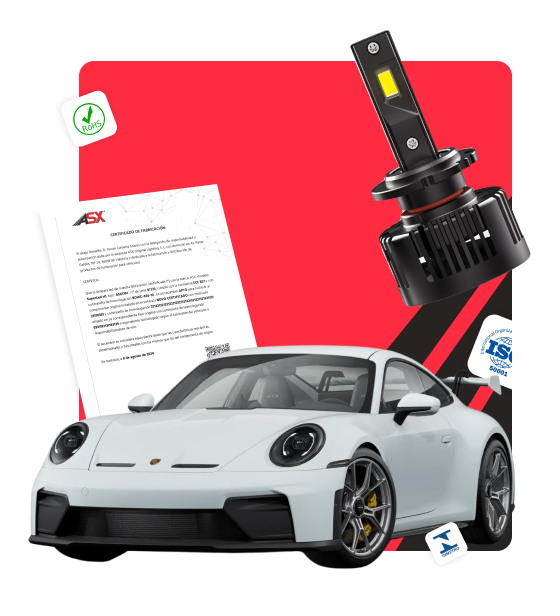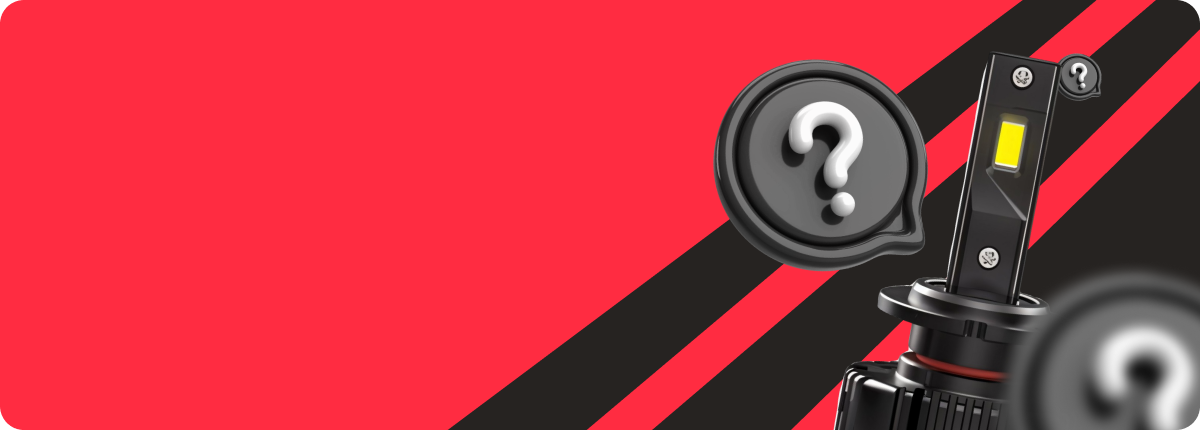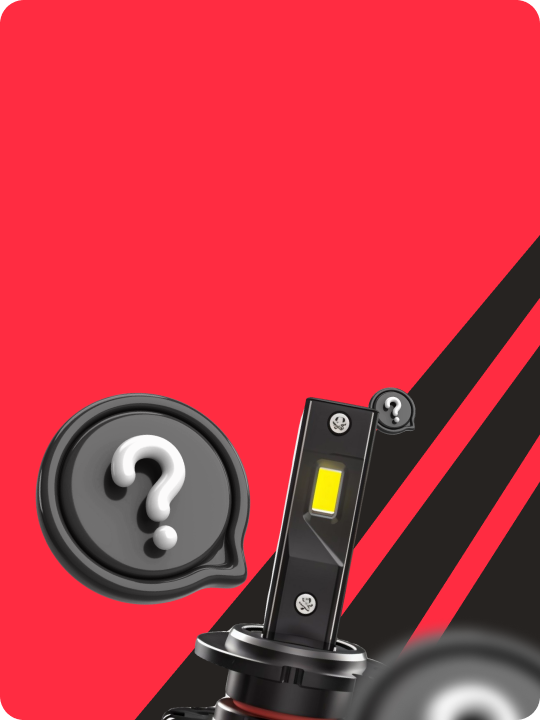Frequently Asked Questions
1. How can I know if ASX LED bulbs are compatible with my vehicle?
All ASX LED bulbs come with certified electromagnetic compatibility (EMC), which ensures they do not interfere with the vehicle’s electronic systems and are technically suitable for installation in 100% of the cars on the market.
However, optical compatibility—meaning the proper projection of the light beam in a headlight originally designed for halogen bulbs—can only be determined through a light beam test carried out in a workshop using a beam setter. This test verifies that the beam cut-off is sharp, correctly aligned, and does not produce dark spots that could compromise visibility or dazzle other drivers.
Although this test is not legally required, it is highly recommended for safety and responsibility purposes, both to ensure proper lighting and to comply with the requirements of the vehicle’s technical inspection (MOT).
As a general guideline, if your vehicle is from the year 2000 or newer and is equipped with projector, lens, or reflector-type headlights, there is a greater than 90% chance that the optics are compatible with an LED bulb.
4. What type of light bulbs does my car use?
It's important to review your vehicle's owner's manual . You can also consult a vehicle professional or an authorized service center.
*That is, if your car uses a halogen H7, in LED it also corresponds to an H7.
5. How to install LED bulbs?
Installing the bulbs is quite easy. First, you anchor the bulb base to the headlight, then insert the bulb and orient it so it produces the correct beam.
Click this link to view the installation manual.
https://asxstore.com/pages/manuals-and-catalogs
*Some headlights may require an adapter; this is generally only necessary for the H7 model and, in rare cases, for the H1.
6. Why don’t I notice a change in lighting after installing LED bulbs in my car?
If you don’t see an improvement in lighting after switching to LED bulbs, it could be due to several factors. First, it’s important to ensure that the bulbs are properly installed in the headlight, as incorrect placement can affect the direction and distribution of light. Additionally, some LED bulbs require a specific orientation to project light optimally, so it’s recommended to check that they are correctly aligned.
Another possible reason is wear on the headlight reflector. If the chrome coating on the internal parabola is deteriorated, the light will not be reflected efficiently, reducing the perceived brightness. It’s also important to consider the compatibility with the vehicle’s electrical system, as some models require additional decoders or resistors for LED bulbs to function correctly.
If, after checking these points, the problem persists, it is best to consult a specialist in automotive lighting to find the best solution.
7. Does my car need an adapter to install LED bulbs in the headlight?
The only bulb models that need an adapter are the H7. For the others, the adapter is the same as the halogen bulb that the car has as standard.
Check this list to see if your car needs it:
*There might be some vehicle models that require an adapter and/or decoder for LED bulbs.. If so, it is recommended that a professional check your car's headlight to see which of the models we have on our website fits it, making an observation and comparing it with the images of our models.
There are models where, due to the trim level or because different headlight manufacturers exist, multiple adapter models may fit. To check if your vehicle needs an adapter, review these two options:
- If the H7 bulbs are secured directly to the headlight with metal clips (no adapter is needed).
- If, on the other hand, the bulb’s own connector acts as the mounting or fastening mechanism for the headlight, then you most likely need an adapter.
Adapters are only required for H7 LED bulbs; other types do not need them.
8. Will my vehicle need a CANbus decoder?
"The need to use a CANbus decoder is not linked to specific vehicle models, but rather depends on the vehicle's equipment.
The more control units it has, the more likely a decoder will be needed. It is an optional accessory, recommended only if a 'bulb out' warning appears on the onboard computer.
Our bulbs are compatible with up to 90% of vehicles. Check our decoder list
9. What is CANbus fault?
This occurs when the warning light "blows out" appears on the dashboard. The car may then stop sending power and the light will flicker or turn off.
This is because the car detects that there is lower consumption, and can interpret this as a blown light bulb.
It is solved with a decoder, which is a resistor so that together with the bulb there is more energy consumption and it is equal to the halogen ones.
It happens rarely, but it can happen.
10. What is the difference between Super and Ultra Led?
Each bulb model has a different light intensity: ULTRA is the most powerful, Super LED is the least powerful, and ECO PLUGIN is somewhere in between. It's also important to consider the compatibility of each model:
- Ultra : 95% compatibility, 23W power and 1,725 lumens.
- Eco Plugin : 80% compatibility, 18W power and 1,350 lumens.
- Super : Not recommended for vehicles with built-in CANbus system, 13W power and 1,170 lumens.
11. In which position should the curved metal shield on an H4 bulb be placed: up or down?
In the case of H4 bulbs, the curved metal shield should be positioned from top to bottom, with the curved part facing the lower side of the headlight. This position is important because the shield acts as both a protector and a light reflector, preventing glare and ensuring that the beam is projected correctly onto the road. If installed upside down, the light will scatter incorrectly and may fail inspection or reduce nighttime visibility. We always recommend checking the original position of the halogen bulb being replaced and replicating it exactly with the LED bulb.
12. Do Super White halogens produce blue light?
Although the bulb is blue, the light is 6000k white, cool white.
13. What is the lifespan of a halogen lamp?
Halogen bulbs have a lifespan of up to 3,000 hours. Our bulbs have a longer lifespan because they are quartz, UV protected and anti-vibration, both the original yellow and super white bulbs.
14. What is the technology behind the ASX LED headlights?
ASX LEDs use the 3570 CSP chip, a more modern chip that can deliver more lumens/watt than a standard CSP chip.
15. What warranty does the product have?
All ASX products have a 3-year warranty, ISO, INMETRO and E-MARK quality certification, and if the products under warranty are not repaired, they are exchanged for a new one.
17. How do you recommend mounting the decoder or canceller for my LED bulbs in the vehicle?
If your LED bulb canceller or decoder is mounted on the vehicle's chassis, it works the same way: it corrects potential electrical errors, such as a burnt-out warning, and ensures adequate power consumption so your LED bulbs work properly.
Ensure a secure connection to the chassis to ensure proper current flow and optimal performance.
It is recommended to mount the decoder on the outside of the headlight to allow proper dissipation of the generated heat and to avoid contact with surfaces that could be damaged by high temperatures, such as plastics or metals.
18. Do T20 mini LEDs have polarity?
Designed without polarity.
19. Will I have a problem with the rear headlight cover?
Our Super and Ultra LED line incorporates a rear heat sink of approximately 3 cm.
If space in the headlight is limited, we recommend opting for the Plug-In line, designed in a 1:1 ratio with halogen bulbs, ensuring compatibility and ease of installation without space issues.
* Please note that it is always advisable to seek professional advice for assembly .
21. When will you restock? / Is stock out?
Currently, due to logistical issues related to imports, we are out of stock for some products. You can sign up for automatic notifications on our website using the "NOTIFY ME" button, and you will receive a notification as soon as the product is back in stock. Thank you for trusting ASX.
Essential points
What type of bulb does my vehicle use?
To identify the bulb model your vehicle needs, refer to the User Manual in the section dedicated to the lighting system. There, you will find detailed information about the recommended bulb types for each lighting function.
Trust the installation to a professional.
It is advisable to entrust the installation to a professional to ensure proper adjustment: that the light beam cut-off is clean and shadow-free and does not dazzle oncoming traffic.
Accessories
Some vehicle models may require an adapter and/or decoder for LED bulbs.

Approval regulations
1. Approval of Our LED Bulbs
At ASX Original Lighting S.L., we take pride in offering high-quality LED lamps, approved and certified according to the strictest and most internationally recognized regulations. Below, we detail the organizations and standards that endorse our products.
2. ATS Group
ATS Group is a laboratory that holds all the necessary approvals and certifications to conduct electromagnetic compatibility tests according to ECE R10. It specializes in testing vehicles, components, systems, and technical units. This group qualifies and certifies the approval of our products, ensuring their compliance with the most stringent international regulations.
3. Regulation EU (EC) 1907/2006 and Regulation (EU) 2019/515
ASX Original Lighting, S.L. complies with Article 33 of Regulation (EC) 1907/2006, ensuring that all our products are approved and certified by the ATS laboratory (AUTOMOTIVE TECHNICAL SERVICE S.R.L.) according to ECE R10 tests. Additionally, our company is registered and certified in Spain, complying with Regulation (EU) 2019/515.

